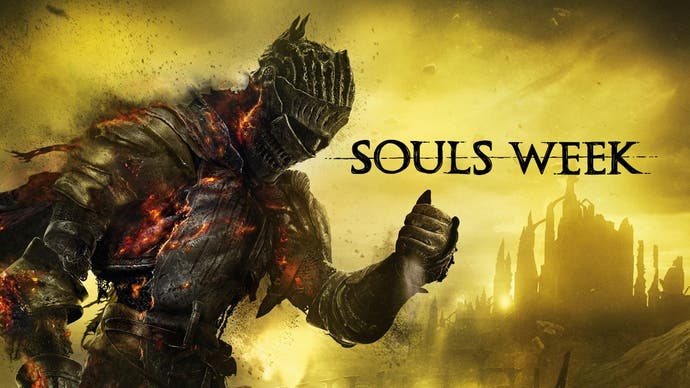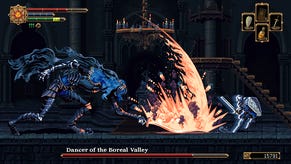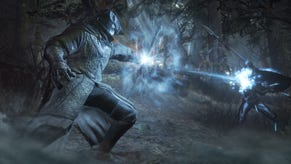Souls Week: Revisiting Dark Souls 3: the Dark Souls 3 of Dark Souls
The blah sheep of the family.
Hello! Souls Week continues today with a look back at Dark Souls 3 - a neglected classic? Inevitably, this piece contains spoilers.
Everybody loves the original Dark souls. It's the game that, after the low-key phenomenon of Demon's Souls, really put From Software on the map; a masterclass in world building and interconnected level design, with enough words written about it that I probably don't need to go on. Then there's Dark Souls 2, the black sheep of the family, with more than its fair share of detractors (all of these people are wrong). And Dark Souls 3? As excellent as it might be, and as much acclaim as was heaped upon it at launch, it's just not a game that appears to elicit much strong emotion either way - no love nor scorn, just a shrug of respectful indifference.
Or maybe I'm projecting? A whole lot of hmmm was definitely how I felt about Dark Souls 3 after my first playthrough six years ago. Maybe it was its close proximity to the masterful Bloodborne and its even more masterful Old Hunters DLC, or maybe it was just general Soulsborne fatigue. Either way, Dark Souls 3 isn't a game I've thought about very much since my first trot through Lothric in 2016, and I certainly wasn't expecting to be quite so thoroughly consumed by it when I decided to revisit it over the New Year.
You can blame the Elden Ring Network Test for most of the words the follow, what with it having had the audacity to end, leaving me with a gaping Souls-shaped void to fill. I turned to the Demon's Souls remake first but ended up bouncing hard off Bluepoint's questionable aesthetic liberties - I have spared you the rant about colour-palette changes and architectural revisionism that was present in the original version of this feature, you'll be pleased to know - eventually settling on Dark Souls 3. It's the Dark Souls I've played the least, meaning its surprises had faded from memory over the years, plus its modern-day lick of paint is still easy on the eyes. And, as an added incentive to return, I realised I'd never actually played its DLC.
So here's the thing. Tackling Dark Souls 3 away from the orbit of The Old Hunters (and indeed the incessant march of the rest of the series, which remarkably began and ended in the space of less than five years), it's far easier to appreciate just how exceptional Dark Souls 3 really is. I realise there's a subset of combat-focused players with concerns above my head that might take umbrage with that statement, but by the time I'd left the High Wall of Lothric that opens the game, I was completely and irreversibly in its grip. I was - and I mean this as literally as is possible in this context - transported by it, consumed by it, vanishing completely into the world of Lothric and arriving out the other side three weeks later in something of a daze. So all-encompassing was the experience, the memory's been stored more like a holiday away to some distant place (albeit one with an unusually high festering corpse count) rather than of playing a game.
World building is, of couse, From's forte; Boletaria, Lordran, Drangleic, Lothric, and Yarnham aren't things of pixels and polygons, these are worlds of mortar and stone, so precisely wrought you can practically smell the aeons of history buried underfoot. And all From's usual narrative tics return in Dark Souls 3 - every meticulous bit of mise-en-scène, every exactingly placed enemy and item, every ephemeral whiff of lore drifting out of item descriptions. But its commanding sense of detail, its eye for a vista and crumbling masonry, has never been better served by the added graphical fidelity enabled here. And shorn of the restrictive palette of Bloodborne's night-drenched gothic squalor, Dark Souls 3 has more room than ever to breathe.
And breathe it does, albeit through the ever-present stench of rot that permeates the game. Dark Souls 3 presents its world like some fucked up Disneyland - a forlorn, festering, ramshackle assemblage of tumbledown huts, overgrown graveyards, busted bridges, and ominous cathedrals, all cowering in reverence to the crumbling magnificence of Castle Lothric at the centre of it all. Every derelict aspect, every angle has a tale to tell. Even its opening segment, the High Wall of Lothric, manages to say so much without saying a word - its cold stone, perpetually held in the grip of a waning autumnal sun, the falling leaves, the piles of corpses clad in impressive armour: the battle is lost, the course is set, and the end of everything draws near. It is a thing of beauty in its absolute bleakest form, From's diseased palette constantly finding new ways to paint its fallen world.
One persistent complaint, of course, is that all this visual richness is offset by a rather more restrictive, rigid structure compared to the knotty ball of string that is the original Dark Souls' world or the wheel-like design of its sequel, each spoke terminating in a similarly complex tangle of environments, albeit more compact this time. Dark Souls 3, though, favours a long, snaking journey, only occasionally breaking and branching to allow for an exploratory exhale. It's a linearity that never quite dazzles as a tour-de-force of world design in the same way as its masterful originator, but I'm not sure that's ultimately all that big a deal.
Instead of that tangled knot, Dark Souls 3 plays out more like a string of pearls, each bead its own self-contained eco-system showcasing From's unmatched skill at designing looping, cross-crossing environments in perhaps its purest form, and each one as radically different in its player demands as it is visually distinct. From Software gets off to an impressive start with the High Wall of Lothric, a suffocatingly vertiginous scene-setter that skips along ramparts and perilous walkways, down into the ominous depths and back up again; from there, the Undead Settlement, scrambling over rooftops, looping beneath bridges and plunging into ravines, then perhaps the first real highlight, the Cathedral of the Deep - a sort of ever-tightening spiral that steadily builds momentum through its giddying opening graveyard gauntlet, thrusting you around and around, up and across rafters, to a memorable battle against two giants and, later, a viscerally satisfying capper as you eviscerate the clergy itself.
And on it goes! Farron Keep, a hilariously mean-spirited open expanse designed to disorientate, distress, and infuriate adventurers; later, Ithryll Dungeon, a squalid descent into pure horror that intermittently thrusts you out of its claustrophobic confines to behold an ancient forgotten city dimly lit below. Then the brilliance of the Grand Archives, a shadowy labyrinth of ancient tomes and grasping Lovecraftian horrors whose very design seems to defy physics. Despite the momentum of its constant upward climb, its path repeatedly bursting out onto the rooftops for another gasp of fetid air, it somehow always manages to spit you back out near the start. Linear the overall Dark Souls 3 journey might be, but each individual leg is anything but.
There's a purity in the game's focus on more self-contained design - a kind of distillation of From's sensibilities that ripples out across all of Dark Souls 3. It is, for instance, perhaps the purest manifestation yet of Dark Souls' secret life as a puzzle game - I'd forgotten, or perhaps just never realised, that Dark Souls' real roadblock isn't so much its difficulty as its trickery. The truth is that - beyond a baseline of combat proficiency - provided you level up, keep your cool, progress slowly, and only take a swipe if you're certain you can land the blow, Dark Souls isn't, I don't think (and I realise I'm in danger of sounding like one of those people here), a particularly tough game.
The key is caution; brute-forcing Dark Souls is like brute-forcing a jigsaw - just because you have all the pieces in front of you (and by pieces I mean your combat tool set of blocks, strikes, parries, rolls, spells and other tricks in this laboured analogy) doesn't mean they'll magically coalesce if you throw them hard enough at the table. Instead, and I think it's more obvious than ever in Dark Souls 3, success comes in considering the myriad different ways those pieces might comfortably fit together to overcome the challenges From graciously lays out.
The strength of Dark Souls 3 in particular, I think, is the sheer variety of these challenges, and the flexibility you're given in which to approach them; watch, wait, analyse, assess, and act, and you'll have an infinitely easier time. And no more is this evident than in its wonderful, wonderful bosses. Dark Souls 3 perhaps doesn't quite have its Ornstein and Smough moment in terms of sheer iconic pizzaz, but holy hell do its bosses shine. They're staggering beauties to behold, as memorable in their design as they are mechanically diverse, each finding clever new ways to test your puzzle solving prowess as much as your reactions.
Plenty has already been written about the stellar likes of the bamboozlingly off-tempo Dancer of the Boreal Valley - all flapping veils and gangly limbs designed to distract from the usual rhythms of play - but there's barely a dud in Dark Souls 3's rich boss line-up. And I'm even counting the more gimmicky inclusions, such as the Deacons of the Deep - a writhing chaos of ferocious melee that's a delightful antithesis to the series' usual considered combat - or Yhorm the Giant, a boss fight that introduces an entirely new weapon then demands you figure out how to use it on the fly while the big fella repeatedly attempts to pound your head into the floor.
There are just so many memorable moments; from the browbeating intensity of the Abyss Watchers - a paranoid dance of simultaneous skirmishes as enemies attack from every side - to the pyrotechnic bedazzlement of Pontiff Sulyvahn, or the haunting last stand of the Twin Princes, a constant cycle of pitiful resurrection as the two brothers defend one another to the death and beyond. The list could easily go on, but I can't finish without a special mention to the Painted World of Ariandel's Sister Friede - a deeply rewarding, dazzlingly choreographed two-hander between the silently swift lead character and her brutish fire-brandishing counterpart that features so many moving parts and demands so much creative application of your entire skillset, I genuinely felt like I deserved a certificate at the end of it all.
Dark Souls 3 isn't always so brilliant. Its numerous narrative (and literal) dead-ends - seemingly a result of last minute, large scale tinkering with the plot and structure - do lend the experience a sort of wonky inelegance that didn't feel particularly From-like on my first play-through, and remains equally awkward all these years later. Even so, it really is remarkable how successfully - both in terms of all-encompassing narrative reach and in sheer formula refinement - it brings the ludicrously convoluted, many stranded, Millenia-spanning Dark Souls story to a close.
Granted, the base game's hasty eagerness to wrap things up just as it's all getting interesting (I'm still pondering the significance of angels, dragon babies, and lapsed gods two months on) doesn't make for a particularly favourable final impression, but it's a flaw more than resolved, I think, by the Ringed City DLC. This final hoorah of two very different but crucially dovetailing chapters not only serves to underscore the series' motif of cyclical death and rebirth, it also fills in some long-lingering plot holes, all in a blaze of well-earned fan-service.
The Painted World of Ariandel brings a melancholy hope to all the misery before it, while the Ringed City itself is a mini-marvel, a series capper that begins with a gleefully literal descent through Dark Souls' history before spitting players out into one of From's most beautiful locations, a verdant crescent of tightly packed Indonesian-style temples overlooking the very edge of time itself. If Dark Souls 3 is a distillation of everything great about Dark Souls, the Ringed City is a distillation of that again.
Grumbles of linearity aside, it's a several-hour-long, breathlessly paced scramble through four stupendous boss fights in one of the series' most elegantly designed environments - seamlessly shifting between ancient temples, crowded city streets, oozing swamps, labyrinthine catacombs, ancient dragon-haunted caverns, even the ultimate end of everything, with such effortless grace, this DLC alone could make bigger titles blush. And in a game that already impresses with its complex web of understated, but still emotionally satisfying NPC side-quests, The Ringed City ends on a doozy; both a perfectly executed punchline in among all the end-of-the-world gloom, and an answer to a minor question fans of Miyazaki have been pondering for years. But I shall say no more.
In the end - and indeed at the end, as a cruel wind blasts ash across all of space and all of time - it's certainly true that Dark Souls 3's more-of-the-same could perhaps never have hoped to capture the imagination of players in the same way as its predecessors did a third time around. But this exercise in refinement is From at the top of its game, smacking against the limitations of the Soulsborne formula as it then stood with dazzling craftsmanship and invention. And when you've stretched a formula as far as it'll go, where to next? We do, of course, now know the answer to that: outwards. Roll on Elden Ring, then, Dark Souls, but more...


















